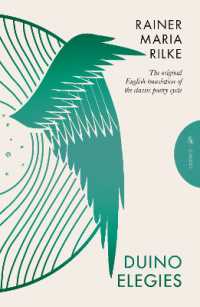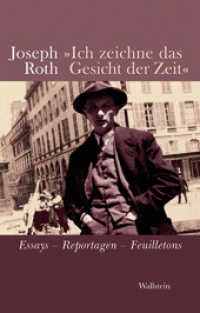- ホーム
- > 洋書
- > 英文書
- > Literary Criticism
Full Description
An alternative genealogy of abstract art, featuring the crucial role of 19th-century German literature in shaping it aesthetically, culturally, and socially.
Once upon a time (or more specifically, in 1911!) there was an artist named Wassily Kandinsky who created the world's first abstract artwork and forever altered the course of art history - or so the traditional story goes. A good story, but not the full story. The Myth of Abstraction reveals that abstract art was envisioned long before Kandinsky, in the pages of nineteenth-century German literature. It originated from the written word, described by German writers who portrayed in language what did not yet exist as art. Yet if writers were already writing about abstract art, why were painters not painting it? To solve the riddle, this book features the work of three canonical nineteenth-century authors - Heinrich von Kleist, Johann Wolfgang von Goethe, and Gottfried Keller - who imagine, theorize, and describe abstract art in their literary writing, sometimes warning about the revolution it will cause not just in art, but in all aspects of social life. Through close readings of their textual images and visual analyses of actual paintings, Andrea Meyertholen shows how these writers anticipated the twentieth-century birth of abstract art by establishing the necessary conditions for its production, reception, and consumption. The first study to bring these early descriptions of abstraction together and investigate their significance, The Myth of Abstraction writes an alternative genealogy featuring the crucial role of literature in shaping abstract art in aesthetic, cultural, and social terms.
Contents
Introduction: The Many Origins of Abstract Art
Apocalypse Now: Heinrich Von Kleist's Sublime De-Framing of Caspar David Friedrich's Der Mönch Am Meer (1810)
The Kleistian Sublime Is Now: Kazimir Malevich, Mark Rothko, Barnett Newman
The Clouding of Perception: Seeing The (Un)Real Potential for Abstraction in the Poetry and Science of Goethe's Clouds (1821)
In the Service of Clouds or Optical Illusion?: Romanticism, Pointillism, and Impressionism
Driven to Distraction and from Abstraction: The Birth and Death of Abstract Art in Gottfried Keller's Der Grüne Heinrich (1854/55, 1879/80)
Inside the Mind and Outside the Margins: The Unruly Lines of Paul Klee, André Masson, and Cy Twombly
Epilogue: Laocoön and His Sisters: The Future of Literature and Art



![聖書の世界 〈1〉 [創世紀]](../images/goods/ar2/web/imgdata2/42553/4255351015.jpg)




